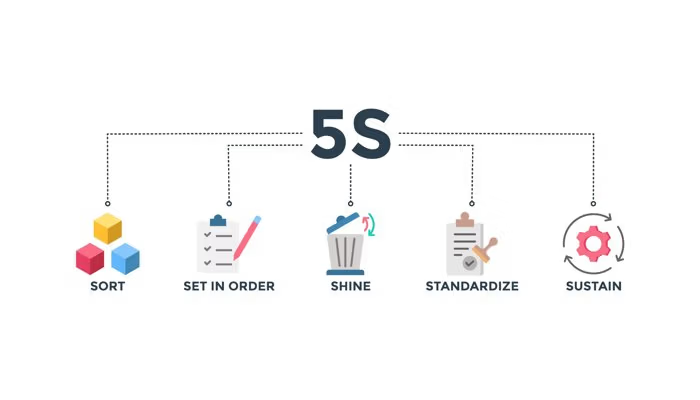Summary: In manufacturing facilities, staying organized and efficient is key to both productivity and safety. One of the best ways to maintain this level of efficiency is by conducting regular 5S audits. If you’re not familiar with with 5S from Lean methodology, it’s a methodology for organizing and maintaining a clean, productive work environment, which stands for Sort, Set in order, Shine, Standardize, and Sustain.
This article will dive into a practical example of how to implement a 5S audit checklist for your manufacturing facility, ensuring you can uphold these principles effectively and boost your overall performance. Using digital tools can make it easier to track progress and ensure adherence to 5S principles across all areas of the facility.
Understanding the 5S Framework
Before diving into the 5s checklist itself, let’s quickly recap the five core elements of 5S and how they apply to a manufacturing environment:
Sort (Seiri): Eliminate unnecessary items from the workplace. This involves sorting through tools, materials, and equipment to determine what is essential and what can be discarded or stored.
Set in Order (Seiton): Arrange the necessary items in a way that they are easily accessible and organized for efficiency. This step is key to creating an efficient workspace. Think of it as “a place for everything and everything in its place.
Shine (Seiso): Regular cleaning and maintenance. A clean workstation is not only more pleasant to work in but also safer and more efficient.
Standardize (Seiketsu): Develop standard operating procedures (SOPs) and regular inspections to ensure consistency in all aspects of the 5S system.
Sustain (Shitsuke): This final step involves instilling habits and continuous improvement. Employees should be trained to maintain the system over time.
How much more efficient could your 5S audits be with digital checklists?
With flowdit, you optimize your audits in real-time, reduce errors, and boost productivity – all without paperwork.
Key Components of a 5S Audit Checklist
Creating a 5S audit checklist helps ensure that each of the 5S principles is being consistently applied in the facility. The goal is to keep operations smooth, minimize waste, and improve both safety and productivity. Below is an example of a checklist you can tailor for your own facility.
Sort (Seiri) Audit Items
Are unnecessary items identified and removed from the workplace?
Look for unused tools, broken equipment, or excess materials that could be stored or discarded.
Are items categorized properly (tools, materials, etc.)?
Ensure that everything in the workspace has a clear purpose.
Is there a designated area for storing unused items?
Items that aren’t in use should be put in a place where they won’t clutter active working spaces.
Set in Order (Seiton) Audit Items
Is the workspace organized so that tools and materials are easy to access?
Evaluate the flow of materials and tools, making sure they follow a logical path to prevent unnecessary movement.
Are labels and signs clearly visible to identify tools and work areas?
A well-labeled workspace promotes efficiency by ensuring everything can be found quickly. Visual cues such as color markings or shapes can further support intuitive orientation.
Are there enough storage solutions for tools and materials?
Check for enough shelves, bins, or cabinets for the organized storage of materials and tools.
Shine (Seiso) Audit Items
Is the facility clean and well-maintained?
This includes checking for clean floors, equipment, and walls.
Are cleaning procedures in place and followed regularly?
Ensure that daily cleaning tasks are documented and that employees are adhering to them.
Is there a regular schedule for maintenance and cleaning of equipment?
Review the schedule and confirm that it’s being adhered to.
Standardize (Seiketsu) Audit Items
Are SOPs in place for sorting, storing, and maintaining tools and equipment?
Make sure that standardized processes are written, clear, and being followed by employees.
Are visual controls (posters, guidelines) used to maintain standards?
Visual management systems (such as signs and color codes) help keep everyone aligned with 5S standards.
Is there an established process for evaluating the performance of the 5S program?
This could include regular reviews and audits to assess the status of the 5S process.
Sustain (Shitsuke) Audit Items
Are all team members trained on 5S principles and their importance?
Consistent training and communication are key to sustaining a 5S culture.
Is there a culture of continuous improvement, with team members suggesting improvements?
Encourage employees to suggest improvements and foster an environment where 5S becomes second nature.
Are 5S principles being regularly reviewed and updated to adapt to new needs?
Regular reviews of the 5S system ensure that it remains effective over time.
📥 Free 5S Audit Checklist Template (PDF)
Steps to Conducting a 5S Audit in Your Facility
Now that we’ve outlined the key components of the checklist, let’s take a look at the steps for conducting a 5S audit process in your facility. These steps not only help identify areas for improvement but also support long-term standardization of workplace practices.
Step 1: Schedule Regular Audits
Set up a recurring schedule for audits. These can be done weekly, monthly, or quarterly depending on the size of your facility and the pace of your operations. It’s important that audits become a regular part of your routine.
Step 2: Designate an Audit Team
Choose a team of auditors who are familiar with 5S principles and can objectively assess the condition of your facility. Ideally, this group should include individuals from different departments, as they can bring diverse perspectives.
Step 3: Perform the Audit
Using the checklist, inspect each area of the facility for adherence to the 5S principles. Take notes, document observations, and highlight areas for improvement.
Step 4: Provide Feedback and Recommendations
Once the audit is complete, share the findings with the team. Be specific in your feedback- point out where the facility is doing well and where it needs improvement. Recommend actionable steps for improvement and provide support for implementing those steps.
Step 5: Implement Corrective Actions
After receiving feedback and reviewing the audit results, prioritize corrective actions based on urgency. These could include removing unnecessary items, reorganizing storage, or developing clearer signage. Set deadlines for making these changes and assign responsibilities to team members to reinforce accountability.
Step 6: Monitor Progress and Conduct Follow-Up Audits
As corrective actions are implemented, monitor progress regularly to ensure that improvements are maintained. Refer to the previous audit report to track changes and plan for follow-up audits to check if the changes have been sustained over time.
Common Mistakes to Avoid in 5S Audits
Even with a thorough checklist and audit plan in place, mistakes can still occur. Here are a few common pitfalls to watch out for:
Overlooking Small Details: Sometimes, minor items – like a misplaced tool or a dirty corner – can be overlooked, but they can accumulate and affect the overall effectiveness of 5S.
Failure to Engage Employees: Employees are key to maintaining 5S. Without their buy-in, even the best audit processes will fall short in reinforcing the 5S methodology. Make sure they are actively involved in both audits and improvements.
Inconsistent Audits: Make sure audits are done regularly. Skipping or postponing audits can lead to a slip in standards and a lack of progress.
Ignoring Feedback: A 5S audit is only effective if feedback is taken seriously. If corrective actions aren’t implemented or followed through, the audit process will lose its value and fail to optimize the 5S implementation.
Why 5S Audits Matter for Manufacturing Facilities
Conducting regular 5S audits offers several benefits for manufacturing facilities:
- Improved Efficiency: A well-organized workspace helps employees find tools and materials faster, reducing time wasted on searching. This focus on organization and efficiency helps to streamline daily operations.
- Enhanced Safety: By removing clutter and keeping the area clean, the risk of accidents and injuries is significantly reduced. These audits contribute to creating a safer work environment.
- Better Quality: A cleaner, more organized space contributes to higher-quality products, as there’s less chance for mistakes or defects due to disorganization.
- Cost Savings: Reducing waste, improving efficiency, and avoiding accidents help to lower operating costs over time.
- Employee Engagement: Involving staff in 5S can increase morale and ownership.
- Sustainability: A clean, organized facility often supports sustainable practices, reducing environmental impact.
Regular audits not only support continuous improvement but also help to optimize productivity across departments.
Conclusion: Keep 5S Going Strong
A 5S audit is a valuable tool for ensuring that your manufacturing facility remains organized, safe, and efficient. By following a clear digital checklist, conducting regular audits, and engaging your team in continuous improvement, you’ll foster a culture of excellence that drives productivity and quality in your operations.
Remember, a 5S audit isn’t just a one-off task - it’s an ongoing commitment to maintaining an organized, safe, and productive work environment. By sticking with the process and staying proactive, you can see long-term improvements in both your workflow and bottom line.
Make 5S audits simpler and more effective with flowdit
Our inspection software streamlines your audit processes, ensuring real-time tracking and efficient management, so you can focus on continuous improvement. Start optimizing your workflows today. learn more about how flowdit. Request a demo
Image: Adobe Stock – Copyright: © texaplanet – stock.adobe.com





